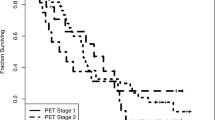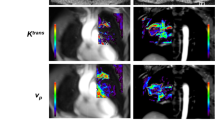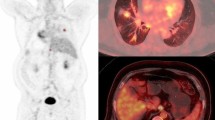Abstract
Purpose
The objective of this study was to evaluate the ability of FDG-PET to predict the response of primary tumour and nodal disease to preoperative induction chemoradiotherapy in patients with non-small cell lung cancer (NSCLC).
Methods
FDG-PET studies were performed before and after completion of chemoradiotherapy prior to surgery in 26 patients with NSCLC. FDG-PET imaging was performed at 1 h (early) and 2 h (delayed) after injection. Semi-quantitative analysis was performed using the standardised uptake value (SUV) at the primary tumour. Percent change was calculated according to the following equation: \({\left( {{\text{SUV}}_{{{\text{after}}}} - {\text{SUV}}_{{{\text{before}}}} } \right)} \times {100} \mathord{\left/ {\vphantom {{100} {{\text{SUV}}_{{{\text{before}}}} }}} \right. \kern-\nulldelimiterspace} {{\text{SUV}}_{{{\text{before}}}} }\). Based on histopathological analysis of the specimens obtained at surgery, patients were classified as pathological responders or pathological non-responders. The clinical nodal stage on the post-chemoradiotherapy PET scan was visually determined and compared with the final pathological stage.
Results
Eighteen patients were found to be pathological responders and eight to be pathological non-responders. SUVafter values from both early and delayed images in pathological responders were significantly lower than those in pathological non-responders. The percent change values from early and delayed images in the pathological responders were significantly higher than those in the pathological non-responders. The post-chemoradiotherapy PET scan accurately predicted nodal stage in 22 of 26 patients.
Conclusion
FDG-PET may have the potential to predict response to induction chemoradiotherapy in patients with NSCLC.




Similar content being viewed by others
References
Jemal A, Thomas A, Murray T, Thun M. Cancer statistics. CA Cancer J Clin 2002;52:23–47
Martini N, Kris MG, Flehinger BJ, Gralla RJ, Bains MS, Burt ME, et al. Preoperative chemotherapy for stage IIIa (N2) lung cancer: the Sloan-Kettering experience with 136 patients. Ann Thorac Surg 1993;55:1365–73
Rusch V, Giroux DJ, Kraut MJ, Crowley J, Hazuka M, Johnson D, et al. Induction chemoradiation and surgical resection for non-small cell lung carcinomas of the superior sulcus: initial results of Southwest Oncology Group Trial 9416 (Intergroup trial 0160). J Thorac Cardiovasc Surg 2001;121:472–83
Mac Manus MP, Hicks RJ, Matthews JP, McKenzie A, Rischin D, Salminen EK, et al. Positron emission tomography is superior to computed tomography scanning for response assessment after radical radiotherapy or chemoradiotherapy in patients with non-small cell lung cancer. J Clin Oncol 2003;21:1285–92
Valk PE, Pounds TR, Hopkins DM, Haseman MK, Hofer GA, Greiss HB, et al. Staging non-small cell lung cancer by whole-body positron emission tomographic mapping. Ann Thorac Surg 1995;60:1573–82
Gambhir SS, Hoh CG, Phelps ME, Madar I, Maddahi J. Decision tree sensitivity analysis for cost-effectiveness of FDG-PET in staging and management of non-small cell lung cancer. J Nucl Med 1996;37:428–36
Ichiya Y, Kuwabara Y, Otsuka M, Tahara T, Yoshikai T, Fukumura T, et al. Assessment of response to cancer therapy using fluorine-18-fluorodeoxyglucose and positron emission tomography. J Nucl Med 1991;32:1655–60
Hebert ME, Lowe VJ, Hoffman JM, Patz EF, Anscher MS. Positron emission tomography in the pretreatment evaluation and follow-up of non-small cell lung patients treated with radiotherapy: preliminary findings. Am J Clin Oncol 1996;19:416–21
Hautzel H, Muller-Gartner HW. Early changes in fluorine-18-FDG uptake during radiotherapy. J Nucl Med 1997;38:1384–6
Zhuang H, Pourdehnad M, Lambright ES, Yamamoto AJ, Lanuti M, Li P, et al. Dual time point 18F-FDG PET imaging for differentiating malignant from inflammatory processes. J Nucl Med 2001;42:1412–7
Yamada S, Kubota K, Kubota R, Ido T, Tamahashi N. High accumulation of fluorine-18-fluorodeoxyglucose in turpentine-induced inflammatory tissue. J Nucl Med 1995;36:1301–6
Kubota K, Itoh M, Ozaki K, Ono S, Tashiro M, Yamaguchi K, et al. Advantage of delayed whole-body FDG-PET imaging for tumour detection. Eur J Nucl Med 2001;28:696–703
Matthies A, Hickeson M, Cuchiara A, Alavi A. Dual time point 18F-FDG PET for the evaluation of pulmonary nodules. J Nucl Med 2002;43:871–5
Demura Y, Tsuchida T, Ishizaki T, Mizuno S, Totani Y, Ameshima S, et al. 18F-FDG accumulation with PET for differentiation between benign and malignant lesions in the thorax. J Nucl Med 2002;44:540–8
Mountain CF, Dresler CM. Regional lymph node classification for lung cancer staging. Chest 1997;111:1718–23
Lee K, Shim YM, Han J, Kim J, Ahn YC, Park K, et al. Primary tumors and mediastinal lymph nodes after neoadjuvant concurrent chemoradiotherapy of lung cancer: serial CT findings with pathologic correlation. J Comput Assist Tomogr 2000;24:35–40
Pauwels EK, McCready VR, Stoot JH, van Deurzen DF. The mechanism of accumulation of tumor-localizing pharamaceuticals. Eur J Nucl Med 1998;25:277–305
Oya N, Nagata Y, Tamaki N, Takagi T, Murata R, Magata Y, et al. FDG-PET evaluation of therapeutic effects on VX2 liver tumor. J Nucl Med 1996;37:296–302
Vansteenkiste JF, Stroobants SG, De Leyn PR, Dupont PJ, Verbeken EK. Potential use of FDG-PET scan after induction chemotherapy in surgically staged IIIa-N2 non-small-cell lung cancer: a prospective pilot study—The Leuven Lung Cancer Group. Ann Oncol 1998;9:1193–8
Akhurst T, Downey RJ, Ginsberg MS, Gonen M, Bains M, Korst R, et al. An initial experience with FDG-PET in the imaging of residual disease after induction therapy for lung cancer. Ann Thorac Surg 2002;73:259–64
Ryu JS, Choi NC, Fischman AJ, Lynch TJ, Mathisen DJ. FDG-PET in staging and restaging non-small cell lung cancer after neoadjuvant chemoradiotherapy: correlation with histopathology. Lung Cancer 2002;35:179–87
Fischman AJ, Thornton AF, Frosch MP, Swearinger B, Gonzalez RG, Alpert NM. FDG hypermetabolism associated with inflammatory necrotic changes following radiation of meningioma. J Nucl Med 1997;38:1027–9
Reinhardt MJ, Kubota K, Yamada S, Iwata R, Yaegashi H. Assessment of cancer recurrence in residual tumors after fractionated radiotherapy: a comparison of fluorodeoxyglucose, l-methionine and thymidine. J Nucl Med 1997;38:280–7
Kubota R, Yamada S, Kubota K, Ishiwata K, Tamahashi N, Ido T. Intratumoral distribution of F-18-fluoro-deoxyglucose in vivo: high accumulation in macrophages and granulation tissues studied by micro-autoradiography. J Nucl Med 1992;33:1972–80
Haberkorn U, Strauss LG, Dimitrakopoupou A, Engenhart R, Oberdorfer F, Ostertag H, et al. PET studies of fluorodeoxyglucose metabolism in patients with recurrent colorectal tumors receiving radiotherapy. J Nucl Med 1991;32:1485–90
Gupta NC, Tamim WJ, Graeber GG, Bishop HA, Hobbs GR. Mediastinal lymph node sampling following positron emission tomography with fluorodeoxyglucose imaging in lung cancer staging. Chest 2001;120:521–7
Author information
Authors and Affiliations
Corresponding author
Rights and permissions
About this article
Cite this article
Yamamoto, Y., Nishiyama, Y., Monden, T. et al. Correlation of FDG-PET findings with histopathology in the assessment of response to induction chemoradiotherapy in non-small cell lung cancer. Eur J Nucl Med Mol Imaging 33, 140–147 (2006). https://doi.org/10.1007/s00259-005-1878-9
Received:
Accepted:
Published:
Issue Date:
DOI: https://doi.org/10.1007/s00259-005-1878-9




